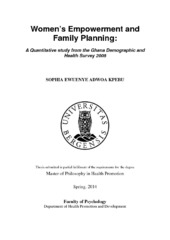| dc.description.abstract | Introduction This study analyses the impact of empowerment on women's health and contraceptive use. Empowerment is a process which enables one to exercise choice. In this study, choice is the present and/or planned use of contraception and its effect on women's health. According to Kabeer's (1999) model of empowerment, the ability to exercise choice is enhanced by access to resources (material, human and social assets) and by agency (decision) latitude. Resources, agency and choice together constitute empowerment. This distinction between empowerment, as an instrument and as a process, is crucial to this thesis because it cannot be measured as a single independent variable. Method This research is a secondary analysis of survey data that were collected as part of a broad research programme on maternal and child health. 4,916 women participants were drawn from the 11,778 households selected from Ghana's ten regions as part of the 2008 Ghana Demographic and Health Survey (GDHS). Three dimensions of empowerment were operationalized using the best existing variables in the GDHS data set. Resources were measured using literacy, education level and occupation (maternal and paternal), household wealth index and ownership of insurance as variables. Agency comprised of the variables which measured the decision latitude about personal medical care, household expenditures, respondent's and partner's knowledge of contraception methods and sources, attitudes towards domestic violence, and views on family planning. Achievement was a single variable measured by the respondent's present use and/intended future use of contraceptives (use or intend to use, or not). Contextual/background variables included respondent's and partner's age, marital status, ethnicity and religion, fertility preferences, administrative region lived in, and urban/rural setting. Achievement was treated as a dependent variable, while resources and agency were independent variables and context/background were treated as control variables. Bivariate analyses and logistic regression were used in sequence to produce a multivariate model of only statistically significant predictors which maximised the variance accounted for in the achievement variable. Results In the multivariate model that accounted for all significant correlates of achievement and that maximised the variance in achievement accounted for (r2 estimates for the final model were between 0.06 and 0.08), the only contextual/background variables were respondent's age and religion. Compared to respondents ages 15- 19, older women were significantly less likely to report not using/planning to use contraception (O.R's for ages 20-24, 25-29 and 30-34 were 0.48, 0.62 and 0.69, respectively). Compared to Christians, non-Christian respondents were significantly more likely to report not using/planning to use contraception (O.R. = 1.50). Among the resources variables, only the respondent's education level and occupation were significant correlates of achievement. Compared to women with secondary or higher education, women with primary education (O.R. = 1.44) and women with no education (O.R. = 1.92) were more likely to report not using/planning to use contraception. Also, compared to women in white collar jobs, unemployed women (but not women... | en_US |
